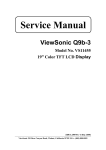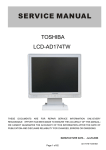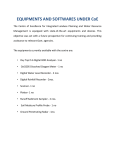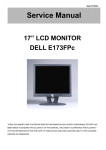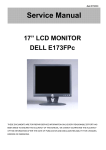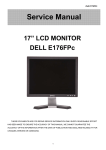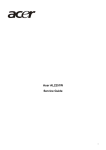Download Acer AL1517 Technical information
Transcript
Acer AL1517 Service Guide Service Guide Version and Revision No. Version Release Date Revision TPV Model Name 1 1.0 May-31-2006 Initial release T566KV5HKGAEAP 1 Copyright Copyright © 2003 by Acer Incorporated. All rights reserved. No part of this publication may be reproduced, transmitted, transcribed, stored in a retrieval system, or translated into any language or computer language, in any form or by any means, electronic, mechanical, magnetic, optical, chemical, manual or otherwise, without the prior written permission of Acer Incorporated. Disclaimer The information in this guide is subject to change without notice. Acer Incorporated makes no representations or warranties, either expressed or implied, with respect to the contents hereof and specifically disclaims any warranties of merchantability or fitness for any particular purpose. Any Acer Incorporated software described in this manual is sold or licensed "as is". Should the programs prove defective following their purchase, the buyer (and not Acer Incorporated, its distributor, or its dealer) assumes the entire cost of all necessary servicing, repair, and any incidental or consequential damages resulting from any defect in the software. Intel is a registered trademark of Intel Corporation. Pentium and Pentium II/III are trademarks of Intel Corporation. Other brand and product names are trademarks and/or registered trademarks of their respective holders. Trademarks Acer is a registered trademark of Acer Incorporated. All other trademarks are property of their respective owners. Conventions The following conventions are used in this manual: Screen messages Denotes actual messages that appear on screen. NOTE Gives bits and pieces of additional information related to the current topic. WARNING Alerts you to any damage that might result from doing or not doing specific actions. CAUTION Gives precautionary measures to avoid possible hardware or software problems. IMPORTANT Remind you to do specific actions relevant to the accomplishment of procedures. 2 Preface Before using this information and the product it supports, please read the following general information. 1. This Service Guide provides you with all technical information relating to the BASIC CONFIGURATION decided for Acer's "global" product offering. To better fit local market requirements and enhance product competitiveness, your regional office may have decided to extend the functionality of a machine (e.g. add-on card, modem, or extra memory capability). These LOCALIZED FEATURES will NOT be covered in this generic service guide. In such cases, please contact your regional offices or the responsible personnel/channel to provide you with further technical details. 2. Please note WHEN ORDERING FRU PARTS, that you should check the most up-to-date information available on your regional web or channel. If, for whatever reason, a part number change is made, it will not be noted in the printed Service Guide. For ACER-AUTHORIZED SERVICE PROVIDERS, your Acer office may have a DIFFERENT part number code to those given in the FRU list of this printed Service Guide. You MUST use the list provided by your regional Acer office to order FRU parts for repair and service of customer machines. Warning: (For FCC Certified Models) Note: This equipment has been tested and found to comply with the limits for a Class B digital device, pursuant to Part 15 of the FCC Rules. These limits are designed to provide reasonable protection against harmful interference in a residential installation. This equipment generates, uses and can radiate radio frequency energy, and if not installed and used in accordance with the instructions, may cause harmful interference to radio communications. However, there is no guarantee that interference will not occur in a particular installation. If this equipment does cause harmful interference to radio or television reception, which can be determined by turning the equipment off and on, the user is encouraged to try to correct the interference by one or more of the following measures: 1. Reorient or relocate the receiving antenna. 2. Increase the separation between the equipment and receiver. 3. Connect the equipment into an outlet on a circuit different from that to which the receiver is connected. 4. Consult the dealer or an experienced radio/TV technician for help. Notice: 1. The changes or modifications not expressly approved by the party responsible for compliance could void the user's authority to operate the equipment. 2. Shielded interface cables and AC power cord, if any, must be used in order to comply with the emission limits. 3. The manufacturer is not responsible for any radio or TV interference caused by unauthorized modification to this equipment. It is the responsibility of the user to correct such interference. As ENERGY STAR® Partner our company has determined that this product meets the ENERGY STAR® guidelines for energy efficiency. Warning: To prevent fire or shock hazard, do not expose the monitor to rain or moisture. Dangerous high voltages are present inside the monitor. Do not open the cabinet. Refer servicing to qualified personnel only. 3 Precautions z Do not use the monitor near water, e.g. near a bathtub, washbowl, kitchen sink, laundry tub, swimming pool or in a wet basement. z Do not place the monitor on an unstable trolley, stand, or table. If the monitor falls, it can injure a person and cause serious damage to the appliance. Use only a trolley or stand recommended by the manufacturer or sold with the monitor. If you mount the monitor on a wall or shelf, uses a mounting kit approved by the manufacturer and follow the kit instructions. z Slots and openings in the back and bottom of the cabinet are provided for ventilation. To ensure reliable operation of the monitor and to protect it from overheating, be sure these openings are not blocked or covered. Do not place the monitor on a bed, sofa, rug, or similar surface. Do not place the monitor near or over a radiator or heat register. Do not place the monitor in a bookcase or cabinet unless proper ventilation is provided. z The monitor should be operated only from the type of power source indicated on the label. If you are not sure of the type of power supplied to your home, consult your dealer or local power company. z The monitor is equipped with a three-pronged grounded plug, a plug with a third (grounding) pin. This plug will fit only into a grounded power outlet as a safety feature. If your outlet does not accommodate the three-wire plug, have an electrician install the correct outlet, or use an adapter to ground the appliance safely. Do not defeat the safety purpose of the grounded plug. z Unplug the unit during a lightning storm or when it will not be used for long periods of time. This will protect the monitor from damage due to power surges. z Do not overload power strips and extension cords. Overloading can result in fire or electric shock. z Never push any object into the slot on the monitor cabinet. It could short circuit parts causing a fire or electric shock. Never spill liquids on the monitor. z Do not attempt to service the monitor yourself; opening or removing covers can expose you to dangerous voltages and other hazards. Please refer all servicing to qualified service personnel z To ensure satisfactory operation, use the monitor only with UL listed computers which have appropriate configured receptacles marked between 100 - 240V AC, Min. 5A. z The wall socket shall be installed near the equipment and shall be easily accessible. Special Notes On LCD Monitors The following symptoms are normal with LCD monitor and do not indicate a problem. Notes z Due to the nature of the fluorescent light, the screen may flicker during initial use. Turn off the Power Switch and then turn it on again to make sure the flicker disappears. z You may find slightly uneven brightness on the screen depending on the desktop pattern you use. z The LCD screen has effective pixels of 99.99% or more. It may include blemishes of 0.01% or less such as a missing pixel or a pixel lit all of the time. z Due to the nature of the LCD screen, an afterimage of the previous screen may remain after switching the image, when the same image is displayed for hours. In this case, the screen is recovered slowly by changing the image or turning off the Power Switch for hours. 4 Table Of Contents Monitor Features ………………………………………………… 6 Induction ………………………………………………… 6 Electrical Requirements ………………………………………………… 7 LCD Monitor General Specification ………………………………………………… 8 LCD Panel Specification ………………………………………………… 9 Support Timing ………………………………………………… 10 Block Diagram ………………………………………………… 11 Main Board Diagram ………………………………………………… 12 Software Flow chart ………………………………………………… 13 Main Board Layout ………………………………………………… 15 Front Bezel ………………………………………………… 16 Rear Bezel …………………………………………………. 17 Operating Instructions ………………………………………………… 18 External Controls ………………………………………………… 18 Front Panel Controls ………………………………………………… 19 Adjusting the picture ………………………………………………… 20 OSD Message ………………………………………………… 23 LOGO ………………………………………………… 24 Chapter 3 Machine Disassembly ………………………………………………… 25 Chapter 4 Troubleshooting ………………………………………………… 33 Chapter 5 Connector Information ………………………………………………… 38 Chapter 6 FRU (Field Replacement Unit) List ………………………………………………… 39 Exploded Diagram ………………………………………………… 40 Schematic Diagram ………………………………………………… 42 Main Board ………………………………………………… 42 Power Board ………………………………………………… 47 Audio Board ………………………………………………… 50 Chapter 1 Chapter 2 Chapter 7 5 Chapter 1 Monitor Features Introduction Scope This specification defines the requirements for the 15” MICROPROCESSOR based Multi-mode supported high resolution color LCD monitor. This monitor can be directly connected to general 15 pin D-sub VGA connector. It also supports VESA DPMS power management and plug & play function. There is a build-in stereo audio amplifier with OSD control to drive a pair of speakers. Description The LCD monitor is designed with the latest LCD technology to provide a performance oriented product with no radiation. This will alleviate the growing health concerns. It is also a space saving design, allowing more desktop space, and comparing to the traditional CRT monitor, it consumes less power and gets less weight in addition MTBF target is 50k hours or more. Chart of AL1517 Panel SVA150XG04TB Signal Interface D-SUB Sync Type Separate / Compatible Color Temp User Adjust Support DDC VESA DDC2B Speaker Yes Headphone Jack Yes Microphone Jack No USB Hub Not support Tilt / Swivel Yes / No 6 Electrical Requirements Standard Test Conditions All tests shall be performed under the following conditions, unless otherwise specified. Ambient light 225 lux Viewing distance 40 cm in front of LCD panel Warm up time All specifications 30 minutes Fully functional 5 seconds Measuring equipment Chroma 7120 signal generator or equivalent, directly Connected to the monitor under test. Control settings User brightness control Maximum (unless otherwise specified) User contrast control Typical (unless otherwise specified) User red/white balance, Green/white balance and In the center (unless otherwise specified) Blue/white balance control Power input 100VAC or 264VAC Ambient temperature 20+5℃ Analog input mode 1024x768/60Hz The units of measure stated in this document are listed below: 1 gamma = 1 nano tesla 1 tesla = 10,000 gauss cm = in x 2.54 lb = kg x 2.2 degrees F = [°C x 1.8] + 32 Measurement systems degrees C = [°F - 32]/1.8 u' = 4x/(-2x + 12y + 3) v' = 9y/(-2x + 12y + 3) x = (27u'/4)/[(9u'/2) - 12v' + 9] y = (3v')/[(9u'/2) - 12v' + 9] Nits = cd/(m2) = Ft-L x 3.426 lux = foot-candle x 10.76 7 LCD Monitor General Specification 15 “ active matrix color TFT LCD Panel type SVA150XG04TB Display size 304.128mm (W) × 228.96mm(H) Pixel pitch 0.297mm(H) × 0.297mm(V) Pixel 1024(H) × 768(V) Pixel Contrast ratio 450:1(typ.) Brightness 250 cd/m2 (typ.) Response time (Tr+Tf) 16ms Display color 16.7M Viewing angle (CR>=10) H: 120 / V: 100 (typ.) Pc interface RGB Analog Interface Signal connector D-Sub 15pin Horizontal Frequency 30KHz----60KHz Interface frequency Vertical Frequency 55Hz ------75Hz Dimensions 342(W)×352(H)×162(D) mm Plug & play VESA DDC2B Power Input voltage 47-63HZ, 100 VAC to 264VAC ±10% Power Consumption (Max.) 35 Watts 8 LCD Panel Specification LCD Panel Model (SVA150XG04TB) z Display Type active matrix color TFT LCD z Pixel 1024(H)×768(V) Pixel z Display Area 304.128mm (W) × 228.96mm(H) z Pixel Pitch 0.297mm(H) × 0.297mm(V) z Display Color 16.7M Colors z Lamp Frequency 55KHz(max.) z Lamp Current 7.5mArms (typ.) z Weight 1000g (typ.) Optical Specifications Measuring Condition: Ta = 25°C(Room Temperature). 9 Supported Timing ٛ. 10 Monitor Block Diagram The LCD MONITOR will contain a main board; a power board, keypad board and which house the flat panel control logic, brightness control logic and DDC. The Inverter board will drive the backlight of panel. Flat Panel and CCFL Drive CCFL backlight Power Board Main Board (Inverter, adapter Board) RS232 Connector For white balance adjustment in factory mode Keyboard AC-IN Host Computer 100V-240V 11 Video signal, DDC Main Board Diagram LCD Interface (CN102) PM25LV512-25SCE SOP-8 (U402) Scaler TSUM16AK (Include: MCU, ADC, OSD etc) (U401) OSD Control Interface (Keypad) D-SUB Connector (CN405) (CN403) EEPROM 24LC02B (U404) 12 EEPROM 24LC16B (U403) Crystal 14.318MHZ (X401) Software Flow Chart 1 Y 2 3 N 4 N 5 Y 6 N 7 8 Y 9 N 10 11 Y N 12 13 Y Y N 14 15 Y 17 18 N N 19 Y 13 16 Remark: 1) MCU initializes. 2) Is the EEPROM blank? 3) Program the EEPROM by default values. 4) Get the PWM value of brightness from EEPROM. 5) Is the power key pressed? 6) Clear all global flags. 7) Are the AUTO and SELECT keys pressed? 8) Enter factory mode. 9) Save the power key status into EEPROM. Turn on the LED and set it to green color. Scalar initializes. 10) In standby mode? 11) Update the lifetime of back light. 12) Check the analog port, are there any signals coming? 13) Does the scalar send out an interrupt request? 14) Wake up the scalar. 15) Are there any signals coming from analog port? 16) Display "No connection Check Signal Cable" message. And go into standby mode after the message disappears. 17) Program the scalar to be able to show the coming mode. 18) Process the OSD display. 19) Read the keyboard. Is the power key pressed? 14 Main Board Layout Label Part NO CN405 088G 35315F H D-SUB 15PIN CN101 033G803412D WAFER U401 056G 562100 TSUM16AK X401 093G 22 53 CRYSTAL 14.318MHzHC-49US U402 056G1133 79 PM25LV512-25SCE SOP-8 U403 056G113356A Description 24LC16B/SNG SOIC-8PIN U404 056G113334A 24LC02B/SNG SOIC-8PIN U702 056G 563 7 AIC1084-33PM U701 056G 585 4 AIC1117-33CY 15 Front Bezel External Controls Front Panel Control Item Description Item Description 1. Auto Adjust / Exit 4. MENU/ENTER 2. < Volume 5. Power Indicator 3. > Volume 6. Power Button 16 Rear Bezel Turn off your computer before performing the procedure below. 1. Plug the power cable of your monitor into a nearby outlet. Plug the other end of the power cord into the PC port. 2. Connect one end of the 15-pin VGA cable to the back of the monitor and connect the other end to the computer’s D-Sub port. 3. Turn on your monitor and computer. Item Description 1. Power Cable 2. Signal Cable 3. Audio Cable 17 Chapter 2 Operating Instructions Press the power button to turn the monitor on or off. The other control buttons are located at front panel of the monitor. By changing these settings, the picture can be adjusted to your personal preferences. • The power cord should be connected. • Connect the video cable from the monitor to the video card. • Press the power button to turn on the monitor position. The power indicator will light up. External Controls Item Description Item Description 1. Auto Adjust / Exit 4. MENU/ENTER 2. < Volume 5. Power Indicator 3. > Volume 6. Power Button 18 Front Panel Control • /Power Button: Press this button to turn the monitor ON or OFF. And display the monitor’s state. • Power Indicator: Green – Power on mode. Orange – Off mode. • Menu / Enter: Activate OSD menu when OSD is OFF or activate/de-activate adjustment function when OSD is ON or Exit OSD menu when in Volume Adjust OSD status. • < / Volume: Activates the volume control when the OSD is OFF or navigate through adjustment icons when OSD is ON or adjust a function when function is activated. • >/ Volume: Activates the volume control when the OSD is OFF or navigate through adjustment icons when OSD is ON or adjust a function when function is activated. • Auto Adjust button / Exit: 1. When OSD menu is in active status, this button will act as EXIT-KEY (EXIT OSD menu). 2.When OSD menu is in off status, press this button for 2 seconds to activate the Auto Adjustment function. The Auto Adjustment function is used to set the HPos, VPos, Clock and Focus. NOTES • Do not install the monitor in a location near heat sources such as radiators or air ducts, or in a place subject to direct sunlight, or excessive dust or mechanical vibration or shock. • Save the original shipping carton and packing materials, as they will come in handy if you ever have to ship your monitor. • For maximum protection, repackage your monitor as it was originally packed at the factory. • To keep the monitor looking new, periodically clean it with a soft cloth. Stubborn stains may be removed with a cloth lightly dampened with a mild detergent solution. Never use strong solvents such as thinner, benzene, or abrasive cleaners, since these will damage the cabinet. As a safety precaution, always unplug the monitor before cleaning it. 19 Adjusting the Picture a. How to Adjust a Setting 1. Press the MENU-button to activate the OSD window. 2. Press < or > to select the desired function. 3. Press the MENU-button to select the function that you want to adjust. 4. Press < or > to change the settings of the current function. 5. To exit and save, select the exit function. If you want to adjust any other function, repeat steps 2-4. Analog-Only Mode 20 b. The Description For Control Function 21 22 OSD Message a. Outline b. The Description For OSD Message Item Description Auto Config When Analog signal input, if User Press Hot-Key “Auto”, will show Please Wait This message, and the monitor do the auto config function. Input Not Supported When the Hsync Frequency, Vsync Frequency or Resolution is out of The monitor support range will show this message. This message will Be flying. Cable Not Analog-Only Model: When the video cable is not connected, will show Connected This message. This message will be flying. No Signal Analog-Only Model: When the video cable is connected, but there is No active signal input, will show this message, then enter power saving. 23 Logo When the monitor is power on, the LOGO will be showed in the center, and disappear slowly. How To Optimize The DOS-Mode Plug And Play Plug & Play DDC2B Feature This monitor is equipped with VESA DDC2B capabilities according to the VESA DDC STANDARD. It allows the monitor to inform the host system of its identity and, depending on the level of DDC used, communicate additional information about its display capabilities. The DDC2B is a bi-directional data channel based on the I²C protocol. The host can request EDID information over the DDC2B channel. This monitor will appear to be non-functional if there is no video input signal. In order for this monitor to operate properly, there must be a video input signal. This monitor meets the Green monitor standards as set by the Video Electronics Standards Association (VESA) and/or the United States Environmental Protection Agency (EPA) and The Swedish Confederation Employees (NUTEK). This feature is designed to conserve electrical energy by reducing power consumption when there is no video-input signal present. When there is no video input signals this monitor, following a time-out period, will automatically switch to an OFF mode. This reduces the monitor's internal power supply consumption. After the video input signal is restored, full power is restored and the display is automatically redrawn. The appearance is similar to a "Screen Saver" feature except the display is completely off. The display is restored by pressing a key on the keyboard, or clicking the mouse. Using The Right Power Cord The accessory power cord for the Northern American region is the wallet plug with NEMA 5-15 style and is UL listed and CSA labeled. The voltage rating for the power cord shall be 125 volts AC. Supplied with units intended for connection to power outlet of personal computer: Please use a cord set consisting of a minimum No. 18 AWG, type SJT or SVT three conductors flexible cord. One end terminates with a grounding type attachment plug, rated 10A, 250V, CEE-22 male configuration. The other end terminates with a molded-on type connector body, rated 10A, 250V, having standard CEE-22 female configuration. Please note that power supply cord needs to use VDE 0602, 0625, 0821 approval power cord in European counties. 24 Chapter 3 Machine Disassembly This chapter contains step-by-step procedures on how to assemble the monitor for maintenance. Disassembly Procedure Disassemble the base 1. Remove hinge cover. (Fig 1-2) 2. Remove four screws mark in red to remove stand base. (Fig 3-4) Fig (1) Fig (2) 25 Fig (3) Fig (4) 26 Disassemble the rear bezel 1. Remove four screws mark in red to remove back cover. (Fig 5-7) Fig (5) Fig (6) 27 Fig (7) Disassemble the shield 1. Remove four screws mark in red to remove the shield. (Fig 8-9) (Remove the shield as arrow direction). Fig (8) 28 Fig (9) Disassemble the main board (Fig 10-12) 1. Remove three screws mark in red to remove main board. 2. Remove two screws mark in red to remove audio board. 3. Remove five screws mark in red and Remove AC-BKT with green to remove Power board. 4. Remove connector wire with main, audio and power board. Fig (10) 29 Fig (11) 5. Remove one screws mark in red to remove Key board. Fig (11-12) Fig (11) Fig (12) 30 Disassemble the front cover (Fig 13) 1. Pay attention to some hooks, then open it with little force till the front cover and Panel frame separated. 2. The position marked with ellipse exists some hooks. Fig (13) left right Fig (14) 31 Top Top bottom bottom Fig (15) Fig (16) Fig (17) 32 Chapter 4 Troubleshooting This chapter provides troubleshooting information for the AL1517: The way of assessing to the factory mode: Main board 1. No power No power Press power key and look if the picture is normal NG Please reinsert and make sure the AC of 100-240 is normal OK Reinsert or check the power section NG Measure U701 PIN2=3.3V, U702 PIN2=3.3V OK NG Measure CN701 PIN5/6=12V? Measure CN701 PIN9/10=5V? X401 oscillate waveforms are normal NG Check power section OK Replace U701, U702 OK Replace U401 NG 33 Replace X401 2. No picture (LED is orange) No picture Measure U701 PIN2=3.3V U702 PIN2=3.3V OK NG Replace U701, U702 X401 oscillate waveforms are normal OK NG Replace X401 Check if the sync signal from computer is output and video cable is connected normally Input the sync signal of NG computer, or change the OK cable Replace U401 34 3. Keypad Board OSD is unstable or not working NG Connect Keypad Board Is Keypad board connecting normally? OK NG Is Button Switch normally? Replace Button Switch OK NG Is Keypad board normally? Replace Keypad Board OK Check main board 35 Power Board 4. No Power No power Check AC line Volt 110V or 220V NG OK Check AC line Check the voltage of C905(+) OK NG Check F901, bridge rectified circuit Check start voltage for the pin3 of IC901 OK NG Check R906, R907,IC901 Check the auxiliary voltage is between 10V-16V OK NG Check IC902,IC903 Check Q901, Q902, ZD901 circuit Check D910, D912 36 5. No Backlight Check C201 (+) =12V OK NG Change F902 Check ON/OFF signal OK NG Check Interface board Check U201 pin9=12V ? NG OK Change Q201 or Q202 Check the pin1 of U201 have saw tooth wave OK NG Change U201 Check D201 (-) has the output of square wave at short time. OK NG Check Q203/Q205/Q207/D201 Check the resonant wave of pin2 & pin5 for PT201 OK NG Check Q209/Q210/C213 Check the output of PT201 OK NG Change PT201 Check connecter & lamp 37 Chapter 5 Connector Information The following figure shows the connector locations on the monitor board: 1 5 6 10 11 15 15 – Pin Color Display Signal Cable (D-sub) 38 Chapter 6 FRU (Field Replaceable Unit) List This chapter gives you the FRU (Field Replaceable Unit) listing in global configurations of AL1517. Refer to this chapter whenever ordering for parts to repair or for RMA (Return Merchandise Authorization). NOTE: Please note WHEN ORDERING FRU PARTS, that you should check the most up-to-date information available on your regional web or channel (http://aicsl.acer.com.tw/spl/). For whatever reasons a part number change is made, it will not be noted in the printed Service Guide. For ACER AUTHORIZED SERVICE PROVIDERS, your Acer office may have a DIFFERENT part number code from those given in the FRU list of this printed Service Guide. You MUST use the local FRU list provided by your regional Acer office to order FRU parts for repair and service of customer machines. NOTE: To scrap or to return the defective parts, you should follow the local government ordinance or regulations on how to dispose it properly, or follow the rules set by your regional Acer office on how to return it. 39 Exploded Diagram (Model: AL1517) 40 Part List Above picture show the description of the following component. Item Picture Description Back Cover 1 Q34G0030 RX 1B Hinge Cover 2 033G4868 RX L Bezel 3 Q34G0029 QWA1B Shield 4 Q85G0006 A S 41 Chapter 7 Schematic Diagram TSUM16AK SCHEMATIC XGA/SXGA B3 LVDS OUTPUT B4 +5V +5V RIN GNDR GIN GNDG SOG BIN GNDB HSYNC VSYNC DDCA_SDA DDCA_SCL DET_VGA RIN GNDR GIN GNDG SOG BIN GNDB HSYNC VSYNC DDCA_SDA DDCA_SCL DET_VGA DDC_WP R+ RG+ GB+ BCLK+ CLKDDCD_SDA DDCD_SCL DET_DVI DDC_WP R+ RG+ GB+ BCLK+ CLKDDCD_SDA DDCD_SCL DET_DVI VCC1.8 VCC3.3 +5V +12V VCC1.8 Vcc3.3 +5V +12V 3.INPUT B5 PA[0..7] PA[8..13] PA[14..19] PB[0..5] +12V PB[6..11] PC5V PB[12..23] +3V3 GPO[0..4] VCC1.8 +5V VCC5V VCC3.3 PA[0..7] PA[0..7] PA[8..13] PA[8..13] PA[14..19] PA[14..19] PB[0..5] PB[0..5] PB[6..11] PB[6..11] PB[12..23] PB[12..23] GPO[0..4] GPO[0..4] ESP ESP OSP OSP VLCD VLCD_12V VLCD B2 on_BACKLIGHT on_Panel on_PANEL_12V +12V PC5V VCTRL +3V3 VCC1.8 +5V Adj_BACKLIGHT VCC5V VCC3.3 VLCD VLCD_12V on_BACKLIGHT on_Panel on_PANEL_12V 5.PANEL INTERFACE VCTRL Adj_BACKLIGHT VLCD VLCD_12V Title 4.SCALER TSUM16AK VLCD_12V Size B 2.POWER Date: 42 Document Number Rev A TOP Monday, May 30, 2005 Sheet 0 of 5 SOT-223 U701 +5V +3V3 H1 H2 VCTRL H3 NC/LT1117-18 9 5 4 TP NC 5 4 9 9 51 1/16W 5 4 5 4 TP 1 2 3 100uF/25V 1 NC 9 8 7 6 8 7 6 5 4 5 4 8 7 6 9 1 2 3 C704 + VCC1.8 TP + C702 1 2 3 9 C703 8 7 6 8 7 6 4 1 2 3 VO +3V3 1 2 3 C701 4 R702 2 8 7 6 VO GND VI 1 2 3 3 4.7uF/16V VCC1.8 4 VCC3.3 4 D701 R31 4.7K 4.7K C51 1UF 1UF R32 0 X R29 X 1K R33 X 4.7K Q4 X MMBT3904 C BL_ADJ(DC) 0V ~ 3.3V 0V ~ 5V 1N4148 B R703 Q702 R31 47 4K7 2K 1/16W C32 N.C 1uF D702 E BL_ADJ P W M D C CHT2907 1N4148 C705 +5V + 1uF/16V R704 +12V R708 +12V C706 C707 + GND GND +12V GND +5V GND 0.1uF 100uF/25V +5V 3,4 +5V 4 CN701 1 3 5 7 9 11 100 1/16W +5V VCC3.3 10K 1/16W 2 4 6 8 10 12 BL_ON BL_ADJ +12V GND +5V GND R710 NC R711 10K 1/16W +5V PC5V C711 4.7K 1/16W R712 on_BACKLIGHT 0.1uF 4 3,4 +5V PC5V Recommond to used "Blue" parts circuit for VCC1.8V if you want to suppoert DDC 3 function when system power off Q703 PMBS3904 R732 R709 CONN C710 + 0.1uF 100uF/25V +5V VCC5V 0 1/16W +5V 2 3,4 10 1/16W D704(SSM12L) Vf=0.38V and If=1A. So when system power on, the system loading is about 400mA (3.3V is about 200mA and 1.8V is about 200mA), So D35 changed from 1N4148(or BAT42) to SSM12L(schottky diode). 1K 1/16W R706 NC 4 R705 4.7K 1/16W Q701 Adj_BACKLIGHT C708 PMBS3904 R707 4.7K 1/16W 1uF D704 D703 BAT54C SMAL140 3 1 +5V +5V VLCD 5 +5V R716 VCC3.3 ADJ C712 + C714 NC 100uF/25V 0.1uF 0.1uF R720 +12V 0 1/16W VLCD_12V +3V3 VLCD_12V R715 R717 R718 10K 1/16W 10K 1/16W 2 4 For RSDS and Panel VCC=12V VLCD R714 VCC3.3 VOUT VOUT R713 +3V3 +5V VIN AIC1084-33PM C713 P.S: The 1N4148 Vf=0.7V~1V can't meet LDO spec. The BAT42, Vf is OK but the If=200mA(forward current) can not meet current spec. +3V3 TO-263 U702 3 R701 1 C709 R729 5 +5V +12V R719 R730 NC R721 NC Q704 AO3401L R723 51K 1/16W 0 1/16W R722 NC/10K NC/10K R731 NC/10K 0 1/16W Q705 AO3401L NC R724 51K NC R725 4 on_Panel Q706 4.7K 1/16W C718 PMBS3904 R726 NC/4K7 C715 0.1uF 4 + C717 Q707 on_Panel_12V 0.1uF PMBS3904 R727 C720 0.1uF 10uF/16V C716 C719 R728 NC/10uF/16V NC/4K7 + 10K 1/16W Title NC/0.1uF TSUM16AK Size B Date: 43 Document Number Rev A POWER Monday, May 30, 2005 Sheet 1 of 5 4 14 R434 56 1/16W C432 0.047uF 0 1/16W R435 56 1/16W C433 0.047uF FB412 0 1/16W R436 56 1/16W C434 0.047uF R437 470 1/16W C435 0.047uF R441 100 1/16W C436 0.047uF R442 100 1/16W C437 0.047uF R443 100 1/16W C438 0.047uF R438 75 1/16W D403 BAV99 3 3 3 16 15 0 1/16W FB411 D404 BAV99 D405 BAV99 RIN 4 GIN 4 BIN 4 SOG 4 GNDR 4 GNDG 4 GNDB 4 +5V D406 +5V ESD_5V MLL5232B 5.6V 2,4 R444 10K 1/16W 1 2 C441 0.1uF 1 C440 0.1uF 2 1 2 C439 0.1uF FB409 120 OHM 100 1/16W DET_VGA 1K 1/16W R446 VSI 4 +5V PC5V 2 R445 HSI 1K 1/16W R447 HSYNC 4 VSYNC 4 1 13 FB410 R440 75 1/16W 12 R439 75 1/16W 17 CN405 DB15 RED+ 1 RED6 GREEN+ 2 GREEN7 BLUE+ 3 BLUE8 4 PC5V 9 PC5V VGA_CON 5 10 11 D407 BAV70 D409 MLL5232B 5.6V R448 C442 R449 C443 2.2K 1/16W 33pF 2.2K 1/16W 220pF D410 MLL5232B 5.6V 3 D408 MLL5232B 5.6V R450 10K 1/16W SCL_VGA SDA_VGA D411 MLL5232B 5.6V R471 D412 MLL5232B 5.6V 4 4 C444 A0 A1 A2 GND 1 2 3 4 0.1uF DDCA_SDA DDCA_SCL DDC_WP +5V 100 1/16W R458 DET_DVI SCL_DVI SDA_DVI DVI5V HPD 4 R455 R456 100 1/16W 100 1/16W DVI5V 4 1 DVI5V 2 10K 1/16W D413 R457 10K 1/16W 3 BAV70 11 3 19 22 D426 LL5232B 5.6V 5% D414 LL5232B 5.6V 5% D415 LL5232B 5.6V 5% D416 LL5232B 5.6V 5% NC DAT0+ DAT0DAT1+ DAT1DAT2+ DAT2- C445 R459 0.1uF 10K 1/16W R462 R463 R464 R465 R466 R467 10 1/16W 10 1/16W 10 1/16W 10 1/16W 10 1/16W 10 1/16W B+ BG+ GR+ R- 4 4 4 4 4 4 4 4 R460 R461 10K 1/16W 10K 1/16W U405 8 7 6 5 C446 VCC WP SCL SDA A0 A1 A2 GND 1 2 3 4 0.1uF M24C02 DDCD_SDA DDCD_SCL DDC_WP 4 +5V R473 DCLK+ DCLK- D422 BAV99 3 D421 BAV99 3 D420 BAV99 3 D419 BAV99 3 D418 BAV99 3 D417 BAV99 3 JACK DVI 3 R468 R469 D423 BAV99 10 1/16W 10 1/16W CLK+ 4 CLK- 4 NC R470 D424 BAV99 1K 1/16W ESD_5V 0.1uF 0.1uF 0.1uF 2 Title D425 1 2 C454 1 2 C453 1 2 C452 1 2 1 C451 0.1uF 0.1uF RLZ36B TSUM16AK Size B 1 0.1uF 2 C450 1 C449 0.1uF 2 C448 0.1uF 1 2 C447 2 18 17 10 9 2 1 13 12 5 4 21 20 23 24 R472 3 DAT0+ DAT0DAT1+ DAT1DAT2+ DAT2DAT3+ DAT3DAT4+ DAT4DAT5+ DAT5clk+ clk- 100 1/16W 100 1/16W VCC WP SCL SDA M24C02 25 26 27 29 28 8 15 6 7 14 16 1 1/3shield 2/4shield 0/5shield clk shield U404 8 7 6 5 VCC5V CN406 R G B RGB GND HSYNC VSYNC SYNC GND DDC SCL DDC SDA +5V HPD R453 R454 R451 R452 10K 1/16W 10K 1/16W Date: 44 Document Number Rev A INPUT Monday, May 30, 2005 Sheet 1 of 5 VDVI VMPLLVPLL AVDD VDDP VDDC VCC1.8 FB401 VDDC VCC3.3 51 AVDD R403 390 1% 62 C401 VCC3.3 0.1uF R486 NC 0.1uF WP 10uF/16V NC 12 97 117 68 VDDC VDDC VDDC VDD_OTP 60 52 14 67 95 103 115 VDDP VDDP VDDP VDDP VDDP AVDD_ADC 4 34 RX2P RX2N RX1P RX1N RX0P RX0N RXCKP RXCKN DDCD_SDA DDCD_SCL BA1P/NC/BA2 BA1N/NC/BA3 BA2P/NC/BA4 BA2N/NC/BA5 BA3P/NC/BA6 BA3N/NC/BA7 RB1P/NC/RB2 RB1N/NC/RB3 RB2P/NC/RB4 RB2N/NC/RB5 RB3P/NC/RB6 RB3N/NC/RB7 REXT REFP SDO CE# SCK SDI 2 1 6 5 70 71 72 73 SDO SCZ SCK SDI CLKBP/LVBCKP/LCK_ODD CLKBN/LVBCKM/LDE NC/LVB2P/NC NC/LVB2M/NC BB1P/LVB1P/BB2 BB1N/LVB1M/BB3 BB2P/LVB0P/BB4 BB2N/LVB0M/BB5 BB3P/NC/BB6 BB3N/NC/BB7 SST25VF010-20-4C-SAE 10K 1/16W RST R404 10K 1/16W NC C421 22pF 32 CLKAP/LVB3P/LHSYNC RSDS/LVDS/TTLCLKAN/LVB3M/LVSYNC R487 19 GB1P/NC/GB2 GB1N/NC/GB3 GB2P/NC/GB4 GB2N/NC/GB5 GB3P/NC/GB6 GB3N/NC/GB7 REFM TSUM16AK VDD HOLD# WP# VSS + C418 NC/LVACKP/NC NC/LVACKM/NC RA1P/LVA2P/RA2 RA1N/LVA2M/RA3 RA2P/LVA1P/RA4 RA2N/LVA1M/RA5 RA3P/LVA0P/RA6 RA3N/LVA0M/RA7 GA1P/NC/GA2 GA1N/NC/GA3 GA2P/NC/GA4 GA2N/NC/GA5 GA3P/LVA3P/GA6 GA3N/LVA3M/GA7 U402 8 7 3 4 ESP OSP GPO0 GPO1 GPO2 GPO3 GPO4 GPO5 GPO6 XIN X401 14.318MHz 33 C423 22pF XOUT GPIO_P22 GPIO_P23 GPIO_P03 VCC3.3 R407 R410 NC NC R415 102 104 GPIO_P16 GPIO_P15 PWM2/GPIO_P24 GPIO_P27/PWM1 MODE[0] MODE[1] GPIO_P16 PWM1/GPIO_P25 R416 +5V 10K 1/16W RST GPIO_P17/SAR0 GPIO_P00/SAR1 GPIO_P01/SAR2 GPIO_P02/SAR3 10K 1/16W 2 GPIO_P06 GPIO_P07 PWM0/GPIO_P26 GPIO_P13 GPIO_P14 ASM810MEURF-T Reset Circuit GND GND GND GND GND GND DDCROM_SCL DDCROM_SDA 11 VCTRL 107 108 109 110 111 112 113 114 PA0 PA1 PA2 PA3 PA4 PA5 PA6 PA7 98 99 100 101 105 106 PA8 PA9 PA10 PA11 PA12 PA13 89 90 91 92 93 94 PA14 PA15 PA16 PA17 PA18 PA19 9 10 15 16 17 18 PB0 PB1 PB2 PB3 PB4 PB5 2 3 5 6 7 8 PB6 PB7 PB8 PB9 PB10 PB11 118 119 120 121 122 123 124 125 126 127 128 1 PB12 PB13 PB14 PB15 PB16 PB17 PB18 PB19 PB20 PB21 PB22 PB23 80 81 88 87 86 85 84 83 82 AVDD C407 0.1uF VCC3.3 FB403 VDDP 2 VCC3.3 600 OHM C408 + 10uF/16V P[0..7] PA[0..7] PA[8..13] C409 C410 C411 C412 C413 0.1uF 0.1uF 0.1uF 0.1uF 0.1uF 5 PA[8..13] PA[14..19] 5 PA[14..19] 5 VCC3.3 2 VCC3.3 FB404 VDVI VCC3.3 2 600 OHM VCC3.3 FB405 PB[0..5] PB[6..11] 5 PB[6..11] PB[12..23] 0.1uF 5 PB[12..23] C414 C415 0.1uF 0.1uF 5 VCC3.3 FB406 ESP 5 OSP 5 GPO[0..4] 2 GPO[0..4] VCC3.3 VMPLL 600 OHM 5 C419 C420 0.1uF 0.1uF R405 DDC_WP 22K 1/16W ESP OSP GPO0 GPO1 GPO2 GPO3 GPO4 3 Q402 PMBS3904 C422 R406 VCC3.3 0.1uF 10K 1/16W R481 on_PANEL_12V R488 2 R482 NC B DET_DVI 3 DET_VGA 3 WP NC on_PANEL +5V VCC3.3 Q405 +5V 100 1/16W 100 1/16W 100 1/16W R422 R423 4.7K 1/16W 4.7K 1/16W VCC3.3 R408 R409 KEY A R483 NC 10K 1/16W R412 10K 1/16W C616 R413 120 1/16W R414 10K 1/16W NC 120 1/16W Q403 R417 R418 R420 R411 2,3 NC 2 on_BACKLIGHT 2 adj_BACKLIGHT 2 KEY1 KEY2 POWER 20K 1/16W PMBS3906 Q401 C424 0.1uF R419 PMBS3906 R421 LED_A 0 1/16W LED_G 0 1/16W Volume AUDIO_MUTE AUDIO_STBY VCC3.3 77 76 VCC3.3 C425 13 38 41 47 96 116 R424 R425 R426 10K 1/16W 10K 1/16W 10K 1/16W R428 R429 8 R427 100 1/16W 7 100 1/16W 6 100 1/16W 5 VCC WP SCL SDA R474 0.1uF U403 A0 A1 A2 GND R475 3.9K 1/16W 1 2 3 4 3.9K 1/16W KEY_AUTO KEY2 AT24C16N-10SC-2.7 R476 Option 1K 1/16W KEY_RIGHT R478 1K 1/16W KEY_A R480 1.5K 1/16W KEY1 FB407 600 OHM VPLL 600 OHM C416 PB[0..5] 20 21 27 28 29 30 31 FB402 600 OHM C404 C405 C406 0.1uF 0.1uF 0.1uF NC 22 23 24 25 VCC3.3 4.7uF/16V 2 75 74 26 35 69 78 79 2 + +12V R477 +12V KEY_B KEY_MENU 1K 1/16W KEY_LEFT R479 1K 1/16W 2 KEY_C +5V +5V 2 2,3 +5V C426 C427 C428 CN404 R484 10K 1/16W R430 1K 1/16W R431 0 1/16W R432 0 1/16W R433 NC Volume Q404 PMBS3904 C431 OUT-L+ OUT-L- 1 3 5 7 9 11 13 2 4 6 8 10 12 14 NC CONN R485 10K 1/16W 0.1uF 0.1uF 0.1uF C429 0.1uF D401C430 D402 RLZ36B 0.1uF RLZ36B CN403 AUDIO_STBY AUDIO_MUTE OUT-R+ OUT-R- 2 +5V FB408 600 OHM LED_G LED_A POWER 1 1 VCC GND U406 3 600 OHM 1 VCC3.3 C417 61 VCTRL C 3 3 39 40 42 43 45 46 48 49 36 37 3 R+ 3 R3 G+ 3 G3 B+ 3 B3 CLK+ 3 CLKDDCD_SDA DDCD_SCL RIN0P RIN0N GIN0P GIN0N SOGIN0 BIN0P BIN0N HSYNC0 VSYNC0 DDCA_SDA DDCA_SCL VCC1.8 C403 E 3 3 AVDD_DVI AVDD_DVI 59 58 56 55 57 54 53 63 64 65 66 3 RIN GNDR R489 R490 3 GIN 3 GNDG 10K 1/16W 10K 1/16W3 SOG 3 BIN 3 GNDB 3 HSYNC 3 VSYNC DDCA_SDA DDCA_SCL 3 AVDD_PLL U401 VCC3.3 AVDD_MPLL AVDD_MPLL 44 50 2 KEY_B LED_G KEY_AUTO KEY_RIGHT POWER OUT-L+ OUT-L- 1 3 5 7 9 11 13 15 2 4 6 8 10 12 14 16 KEY_A LED_A KEY_MENU KEY_LEFT KEY_C OUT-R+ OUT-RTitle TSUM16AK CONN Size C GND Date: 45 Document Number Rev A SCALER Monday, May 30, 2005 Sheet 1 of 5 4 4 PA[0..7] 4 PA[0..7] PA2 PA3 PA4 PA5 PA6 PA7 4 PA[8..13] PA0 PA1 PA2 PA3 PA4 PA5 PA6 PA7 PA12 PA13 RA1P RA1N RA2P RA2N RA3P RA3N PA[8..13] PA8 PA9 PA10 PA11 PA12 PA13 PB[0..5] PB[0..5] PB0 PB1 PB2 PB3 PB4 PB5 PA[0..7] PA[0..7] LVACKP LVACKM LVA2P LVA2M LVA1P LVA1M LVA0P LVA0M LVA3P LVA3M 4 4 GB1P GB1N GB2P GB2N GB3P GB3N PB[12..23] PB[12..23] PB14 CLKBP PB15 CLKBN 4 PA[14..19] 4 PA14 PA15 PA16 PA17 PA18 PA19 PB[12..23] BA1P BA1N BA2P BA2N BA3P BA3N PB12 CLKAP PB13 CLKAN PB[12..23] PB12 PB13 PB14 PB15 PB16 PB17 PB18 PB19 PB20 PB21 PB18 PB19 PB20 PB21 PB22 PB23 LVB3P LVB3M LVBCKP LVBCKM LVB2P LVB2M LVB1P LVB1M LVB0P LVB0M 4 4 GPO[0..4] GPO[0..4] RP101 GPO0 GPO1 GPO2 GPO3 GPO4 1 2 3 4 R110 4 NC 8 7 6 5 NC GPOO0 GPOO1 GPOO2 GPOO3 GPOO4 2 OSP ESP BB1P BB1N BB2P BB2N BB3P BB3N OSP R101 NC/0 ESP R102 NC/0 C106 C107 NC NC VLCD VLCD VLCD_12V C101 C102 C103 C104 C105 NC NC NC NC NC 2 VLCD_12V RA2N RA2P FB1N FB1P RA1N RA1P FB2N FB2P GA3N GA3P FG0N FG0P GA2N GA2P FG1N FG1P GA1N GA1P FG2N FG2P CLKAN CLKAP FCLKN FCLKP BA3N BA3P FR0N FR0P BA2N BA2P FR1N FR1P BA1N BA1P FR2N FR2P GPOO1 GPOO0 STH LP POL STV2 GPOO3 GPOO2 GPOO4 CLKV STV1 OE R103 NC R104 R105 R106 R107 NC NC NC NC R108 R109 NC NC CN103 1 2 3 4 5 6 7 8 9 10 11 12 13 14 15 16 17 18 19 20 21 22 23 24 25 26 27 28 29 30 31 32 33 34 35 36 37 38 39 40 41 42 43 44 45 46 47 48 49 50 FB0N FB0P RA3N RA3P PB[6..11] PB[6..11] PB6 PB7 PB8 PB9 PB10 PB11 GA1P GA1N GA2P GA2N GA3P GA3N CN102 RB1P RB1N RB2P RB2N RB3P RB3N 1 2 3 4 5 6 7 8 9 10 11 12 13 14 15 16 17 18 19 20 21 22 23 24 25 26 27 28 29 30 RB3N B0N RB3P B0P RB2N B1N RB2P B1P RB1N B2N RB1P B2P GB3N BG0N GB3P BG0P GB2N BG1N GB2P BG1P GB1N BG2N GB1P BG2P CLKBNBCLKN CLKBP BCLKP BB3N BR0N BB3P BR0P BB2N BR1N BB2P BR1P BB1N BR2N BB1P BR2P IL-FHR-B30S-HF (JAE) CN101 LVB0M LVB1M LVB2M LVBCKM LVB3M LVA0M LVA1M LVA2M LVACKM LVA3M RXO0RXO1RXO2RXOCRXO3RXE0RXE1RXE2RXECRXE3- 1 3 5 7 9 11 13 15 17 19 21 23 2 4 6 8 10 12 14 16 18 20 22 24 RXO0+ RXO1+ RXO2+ RXOC+ RXO3+ RXE0+ RXE1+ RXE2+ RXEC+ RXE3+ LVB0P LVB1P LVB2P LVBCKP LVB3P LVA0P LVA1P LVA2P LVACKP LVA3P IL-FHR-B50S-HF (JAE) CONN VLCD CN7 CN8 CN9 RP1 R88 R89 R91 Table 1 Table 1 LVDS Panel RSDS Panel X V X V V X X V X V X V X V R90 R92 R93 R94 R95 R96 VLCD R97 2 X V NC 3.3V 0R 3.3V 0R 3.3V 0R 3.3V 0R AU 17 QDI 17 CPT 17 INNOLUX 15 HannStar 15 CPT 15 LG 15 Innolux 17" NC NC 12V 0R NC NC NC NC 5V 0R 5V 0R NC 3.3V 0R 3.3V 0R 3.3V 0R 3.3V 0R NC NC NC NC 3.3V 0R NC 12V 0R NC 12V 0R NC NC 5V 0R NC NC 12V 0R NC NC NC NC NC 3.3V 0R NC NC Title TSUM16AK Size B Date: 46 Document Number Rev A PANEL INTERFACE Monday, May 30, 2005 Sheet 1 of 5 Power board (adapter + inverter) 47 48 Audio board OUT_LOUT_R +12V 12V 10K 9 R212 6 33L8022-3A-H FEMALE 11 220K C211 100 pF R210 R211 5.6K GND 5.6K 12 GND C212 100 pF + C209 1.0uF + C210 1.0uF C213 0.1uF GND 49 15 GND CN203 + VS 16 INL OUTL INR OUTR SVR VOLUME STBY VAROUT_R MUTE VAROUT_L GND C203 0.1uF 17 4 3 2 1 470uF/16V 14 + C206 0.47uF R203 C202 470uF/16V 10 C207 470uF/16V 7 WAFER 4P2.0 R/A 5 + C208 470uF/16V GND R207 R208 1K 4 10K + C201 470uF/16V C205 GND GND GND GND GND GND GND R201 + U201 TDA7496L 1 2 3 13 18 19 20 1 2 3 C204 0.47uF VS CN204 8 GND PIN-1 NC VOLUME 14 12 10 8 6 4 2 STANDBY 13 11 9 7 5 3 1 PIN-1 MUTE 1K CN202 WAFER 2*7P 2.54mm PIN-3 GND


















































